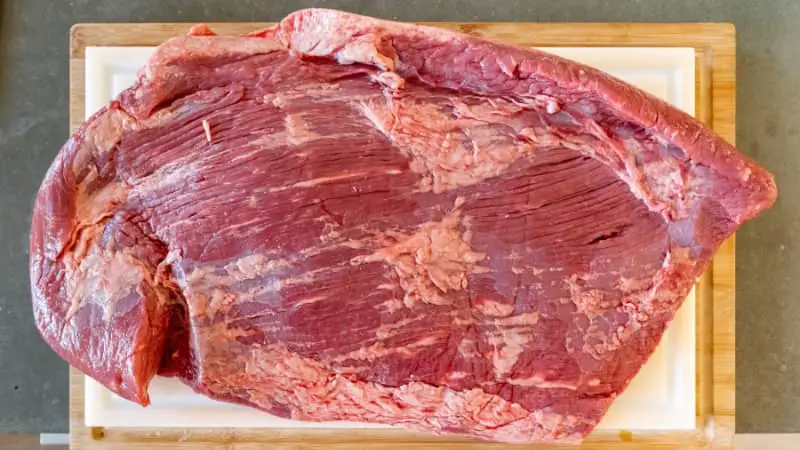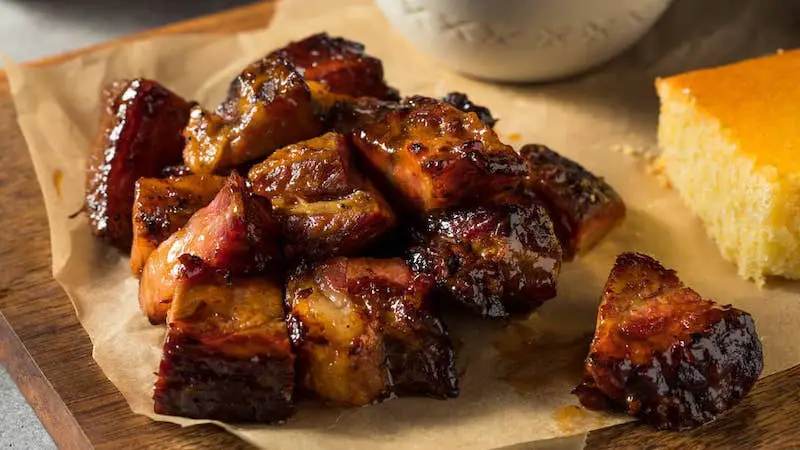If you have raw, frozen brisket, you have two options. First, you can defrost it, then cook it. Second, you can cook the brisket from frozen.
While cooking from frozen may sound more convenient, there’s more room for error during the cooking process, especially if you’re smoking it.
I recommend thawing the brisket first unless you’re experienced with your smoker. In this guide, you’ll learn the three best methods to defrost brisket (and one to avoid) to prepare your brisket for your next BBQ.
Key Takeaway
The best way to thaw a brisket is to leave it in your fridge. It takes 24 hours to defrost every 5 lbs of brisket. You can use the cold water method if you’re short on time.
3 Ways to Thaw a Brisket
Here are the safest ways to unfreeze your brisket before smoking it.
Method 1: Refrigerator Thawing
The safest and most effective way to defrost a brisket is to let it thaw in the fridge because the meat stays at a consistent temperature.
It usually takes 24 hours for every 5 pounds of beef brisket to unfreeze completely. So planning ahead is essential, as larger cuts might take several days to thaw.
Here are a few things to keep in mind when thawing brisket in the fridge:
- Ensure the fridge temperature is between 35°F to 40°F. [1]
- Place the brisket on a tray to catch leaking juices.
- Use your fridge’s lowest shelf to avoid cross-contamination with other food.
- Cook the meat within 3 to 5 days after thawing. [1]
Method 2: Cold Water Thawing
If you’re in a time crunch, using the cold water method to thaw a brisket can be a great option. Not only is it faster than using the fridge, but it also maintains a safe temperature for the meat.
Here are the steps for the cold water method:
- Place the brisket in a leak-proof plastic bag (and remove the air), or use its original Cryovac packaging to prevent water from entering.
- Submerge the bag with the brisket in cold water in a sink or container.
- Ensure the water temperature remains below 40°F to avoid any bacteria growth. You can change the water every 30 minutes to keep it cold.
This method generally takes approximately 30 minutes per pound of meat to thaw, so plan accordingly.
To ensure that your brisket has defrosted, gently press the meat and check for any signs of firmness or ice crystals. If you notice either of these, give it more time to thaw.
Method 3: Fridge and Cold Water Combination
If you started with the refrigerator method but need to speed up the timeline, you can switch to the cold water method.
Since the cold water method keeps the meat at the same temperature as the fridge, you don’t have to worry about jeopardizing food safety.
To use this approach, remove the brisket from the fridge, wrap it in a leak-proof plastic bag, and follow the steps outlined in the section above.
Don’t Defrost a Brisket in the Microwave
Other websites say you can use a microwave to reheat brisket. DON’T FOLLOW THAT ADVICE! Unlike smaller cuts of meat like steak, brisket is large, making it more challenging to defrost.
Here’s why you shouldn’t rely on your microwave’s defrost feature:
- It can lead to uneven thawing, making parts of the brisket undercooked.
- It can cause the outer layers to become dry and tough, compromising the overall quality of the meat.
- Microwaves generate heat quickly, which can encourage bacterial growth if the meat is not thoroughly cooked immediately after thawing.
Thaw your brisket in the fridge, or use cold water for the best results. This practice ensures the meat thaws consistently and maintains its desired texture and taste while also being a safer option.
How to Reduce Cross-Contamination Risks
It’s vital to prevent cross-contamination when thawing a brisket to reduce the risk of foodborne illnesses spreading to other food items.
The following practices will help to avoid cross-contamination:
- Always thaw brisket on a clean plate or tray, preferably at the refrigerator’s bottom shelf, to catch any dripping juices and prevent contamination of other foods.
- Use separate cutting boards and utensils for raw meat. Choose a non-porous cutting board, which is easier to clean and disinfect.
- Clean and sanitize all surfaces, cutting boards, and utensils that come into contact with the raw brisket before using them for other foods.
- Wash your hands thoroughly with warm water and soap before and after handling raw meat to minimize the transfer of bacteria to other surfaces and food.
By keeping these safety considerations and precautions in mind, the risk of bacterial growth and cross-contamination while thawing your brisket can be significantly reduced.
Frequently Asked Questions
Check out the FAQs below if you still have questions about defrosting brisket.
Is It OK to Thaw a Brisket at Room Temperature?
No, it’s not safe to thaw brisket at room temperature. That can cause bacteria to grow, increasing the risk of foodborne illness. Always use the refrigerator or the cold water method for thawing.
Can I Cook a Brisket From Frozen?
Although challenging, cooking a frozen brisket is possible. However, I only recommend it if you have previous experience cooking brisket, as it requires careful attention to ensure that the center is fully cooked without burning the outside.
What’s the Best Way to Thaw Cooked Brisket?
The best way to thaw cooked brisket is by placing it in the fridge. If you’re pressed for time, use the cold water method mentioned in this article.
Is It Safe to Leave a Frozen Brisket out Overnight?
No, it’s not safe to leave brisket out overnight. According to the FDA, you shouldn’t leave beef out of the fridge for longer than 2 hours, or it could begin developing harmful bacteria.
Final Thoughts
To maintain the brisket’s tender taste, ensure you defrost it properly by resting it in the fridge and allowing it to thaw.
Alternatively, if you’re short on time, submerge it in cold water until it thaws. However, avoid taking shortcuts like using the microwave, as that could ruin the brisket’s taste and texture.


